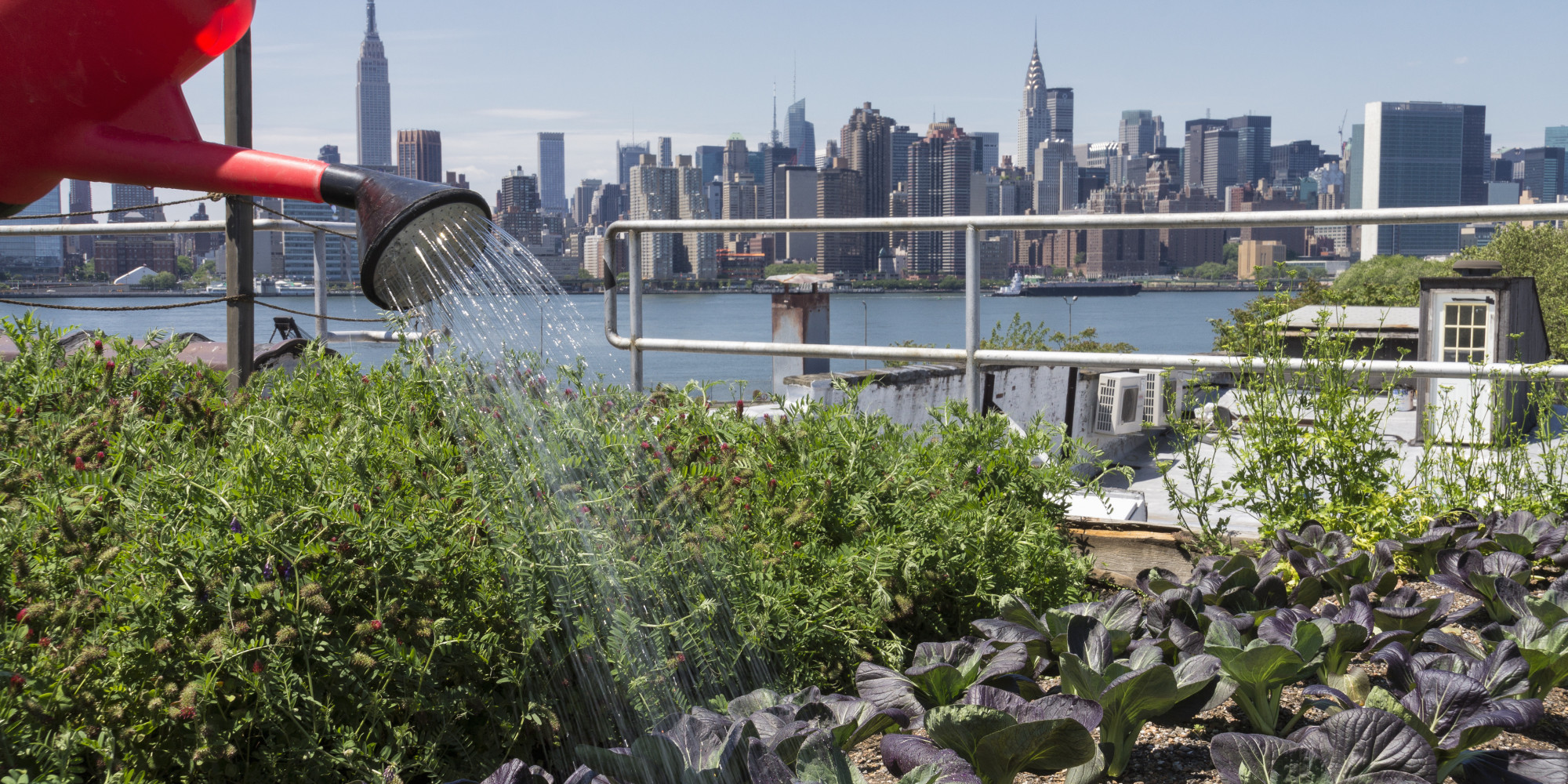99 Urban Farming Facts you did not know

1. An average 10x20 urban farming plot in New York City can produce in between $500 and $700 worth of edible food in one season 1 .
2. In the city of Cleveland, Ohio, if 80% of every vacant lot, 62% of commercial rooftop space, and 9% of every residential lot was used for urban farming , all of Cleveland’s fresh produce needs could be met with produce grown within city limits.
3. Half of the vacant land in Detroit, Michigan is capable of producing enough fresh fruits and vegetables to meet 65% of vegetable demand as well as nearly half of non-tropical fruit demand within city limits.
4. If all of the vacant land in New York city was used for the urban farming of produce, over 150,000 people could be fed using urban grown fresh produce.
5. The city of Burlington, Vermont could meet nearly 110% of its annual fruit demand with locally grown fruits if it implemented a urban farming set up utilizing all available land and resources.
6. The average American city on average needs to dedicate just 10% of its city limit area to urban farming to produce the entire recommended vegetable intake of its population.
7. Peri-urban agriculture in Australia is responsible for one-fourth of the nations total agricultural output, yet only utilizes 3% of total Australian land used for agriculture.
8. More on Australian urban agriculture: Multiple cities in Australia utilize peri-urban agricultural practices to provide over 90% of fruit and vegetable demand within respective city limits.
9. More on peri-urban agriculture: if peri-urban agricultural techniques were applied to all available land in the New York city metropolitan area, up to 89% of New York City’s fresh fruit and fresh vegetable demand, excluding tropical fruits such as bananas and mangoes, could be provided locally.
16. Large scale commercial hydroponic urban farms will sometimes sell fish products in addition to grown produce and herbs grown, such as tilapia or perch.
17. A 2012 study of commercial urban farmers revealed that among 370 operations the average annual revenue was approximately $54,000.
18. About 120 of the 370 urban farmers polled from the study above stated that the urban farm they operated was their sole source of income.
19. 81% of commercial aquaponic urban farming operations in the world are located in the United States.
20. The primary sub-categories of urban farming are classified as hydroponic and vertical farming, rooftop farming and rooftop greenhouse farming, edible walls and landscaping, peri-urban farming, and community garden / traditional garden urban farming.
21. The first recorded instances of urban farming date back over 3,000 years to ancient Egypt. In the 1400’s, urban farming was incorporated into the construction plan for Machu Picchu .
22. In the United States, urban agriculture was first adapted on a large scale on vacant lots in Detroit Michigan in 1893, under the direction of its then mayor, Hazen Pingree (1840-1901)
23. Commercial rooftop urban farming is a relatively recent development: The first legally operated urban rooftop farm did not open in New York city until 2010, for example.
24. In 1919, at the request of President Woodrow Wilson, urban farming became an extremely popular means of producing foods that could no longer be imported from Europe. These war-time trade restrictions resulted in the planting of over 5 million small urban farming plots .
25. During the great depression, over $1 million dollars worth of produce was grown on urban farming plots ($15.7 million adjusted for inflation in 2016).
26. The earliest large scale urban rooftop greenhouses were built in New York City in 2011. Similar projects increased exponentially in the following years.
27. According to a urban agriculture study from the University of Cardiff, urban farming projects on rooftops can reduce environmental temperature increase by up to 20.3 degrees Fahrenheit / 11.3 degrees Celsius.
28. Vertical farming in urban spaces such as apartments or small outdoor balconies can generate 10x more fresh produce by volume then the same area used via conventional farming techniques.
29. If 50% of the applicable urban rooftop area in Tokyo was adapted for urban farming space and/ or urban gardening space, the average annual temperature within city limits would decrease by .11-.84 degrees Celsius / .2 – 1.6 degrees Fahrenheit.
30. If the above temperature decrease occurred in Tokyo, over 100 million yen (approximately $1 million USD) less would be spent per year on cooling.
31. Singapore is one of the world leaders in urban farming and agricultural policy. The republic of Singapore is home to over 5 million people but has a size of only 715 square kilometers.
32. Urban roofs covered with greens can absorb up to 87% of solar radiation compared to a standard roof.
33. Research from UC Davis suggests that the average urban garden used to cultivate food will produce approximately $200-400 worth of produce per year.
34. The average conventionally grown item of produce travels over 1500 miles (2400 km) in transport distance from farm to consumption, according to research from Iowa State University. The majority of urban farmed produce will travel less than 1% of this distance.
35. Research from the same study found that, compared to urban and local agricultural practices, conventional agriculture, in terms of transportation costs, can have up to 1700% more fuel and carbon dioxide emissions.
36. A 40 x 50 meter plot of rooftop with simply uncut grass has the potential to absorb over 2000 kg of pollutants that are often present in urban centers.
37. One square meter of green agricultural rooftop space in a city can offset the annual carbon emissions of one automobile, according to green roof studies .
38. There is evidence that urban agriculture can decrease noise pollution within urban areas.
39. There is a proven link between the amount of noise pollution urban residential real estate is exposed to and the value of the property.
40. One inner-city agriculture study has demonstrated that urban residents who cultivate city farming projects consume 40% more fresh produce then the average citizen.
41. The same study participants were 350% more likely to consume the daily fresh fruits and vegetables in quantities at or above 5 servings per day.
42. Local agriculture research completed in 2005 from the University of Waterloo found that if the city of Waterloo switched entirely to production and consumption of produce cultivated via urban farming methods, the town would prevent the emission of over 50,000 metric tons of carbon dioxide from entering the atmosphere.
43. According the same study, this amount of carbon emission prevention would be equivalent to the cumulative carbon emissions of 16,191 automobiles.
44. Waterloo, Ontario has an area of approximately 24 square miles and a population of 100,000 residents roughly. Los Angeles has approximately 3.8 million residents (38x the size of Waterloo) and an area of 503 square miles (21x the area of Waterloo). Using the area as a proxy, if Los Angeles also adapted local agricultural practices to the maximum potential of its area, at least 1 million metric tons of CO^2 emissions could be avoided.
45. 1 Million metric tons of Carbon Dioxide emissions would be roughly equivalent to the greenhouse gas emission collectively caused by 323,800 cars. Therefore, we can expect a total adaptation of urban agriculture within the Los Angeles city limits (based off data from Waterloo, Ontario and using urban area in square miles as a proxy) to eliminate the emissions produced by approximately 323,800 vehicles per year.
46. The elimination of nearly half a million cars worth of greenhouse gas emissions is an excellent start. Unfortunately, there are over 250,000,000 registered 2-axel vehicles in the United States, meaning 323,800 vehicles is approximately .12% of the total amount of 2-axel vehicles in the United States.
47. Fresh produce items grown in urban rooftop greenhouses require supplemental carbon dioxide to be grown effectively. One common method of producing this supplemental CO2 is, ironically, the burning of fossil fuels.
48. Depending on the type of produce being grown in a greenhouse, the amount of supplemental carbon dioxide required may be over 3 times normal atmospheric concentrations.
49. Certain methods of introducing supplemental Carbon dioxide into greenhouses produce non-ideal byproducts that can have adverse effects on the plant health. To give one example, many types of furnaces that can be used for carbon dioxide supplementation in greenhouses also introduce elevated levels of ethylene into the greenhouse atmosphere, accelerating aging and decreasing the freshness of produce being grown.
50. By the year 2050, approximately 80% of the world’s population is projected to live in urban or suburban areas. Additionally, between 2015 and 2050, the world population is projected to grow by over 3 billion people.
51. The ability to produce crops year-round has impressive implications on the output of food from indoor farming operations . On average, crops farmed in vertical farming indoor in urban areas will yield 400%-600% of traditional seasonal agricultural yield.
52. For some crops such as strawberries, vertical farming year round production can result in as much as a 3000% increase in growing efficiency compared to traditional outdoor growing techniques and practices.
53. There is a proven correlation from research conducted by the NIH in 2008 between the cultivation of urban farming projects the willingness to try new fruits and vegetables in unfamiliar or foreign cuisine.
54. Data from the same study suggests that urban gardeners are less likely to eat unhealthy foods such as candy.
55. The typical 5-10 day transportation process for fresh produce from farm to consumer can result in significant weight loss , culminating in a 30-50% reduction of nutrient quantity. Locally sourced and grown fresh produce does not have this transport delay, and can maintain the 30-50% of nutrients that would otherwise be lost before consumption.
56. In many countries over 30% of fresh produce harvested is wasted due to spoilage and infestation exacerbated by extended supply chains.
57. One prominent study suggests that one 30 story building covering one city block (approximately 5 acre area) devoted entirely to indoor vertical farming could produce the same food output as 2400 acres of traditional farming , assuming optimal produce types are grown for the given conditions.
58. “Dwarf” versions of crops are often incorporated into urban agriculture plans, due to their diminished size but traditionally non compromised nutritional content compared to larger versions.
59. The lack of predictability of weather has dire consequences for traditional, rural, outdoor farmed foodstuffs. According to a piece written by Michael Pollan in the New York Times in 2009, certain rainfall deviations gradually occurring over the next decade in India could cause the traditional agricultural output of the sub-continent to be reduced by 30% .
60. Another statistic on weather risk for non-urban farming style agriculture: large cataclysmic weather events have historically incurred massive losses in traditional agriculture. Just 3 major floods in the United States in 1993, 2007, and 2008 resulted in over $1 billion dollars in cumulative lost crops. Urban farming is generally less susceptible to extreme weather due to its often protected nature.
61. From a community enrichment perspective, urban agriculture has a significant return on investment: there is evidence that $1 invested into an urban vegetable growing project can yield up to $6 dollars of vegetable output in lifetime value .
62. Increased urban agriculture and green roof space has been linked to decreased rates of asthma in the surrounding urban population.
63. According to the New York Times, lead contamination is one common source of urban farming soil contamination . Best practices can nearly completely eradicate likelihood of soil contamination.
64. In response to 2002 food shortages , over 30,000 acres of urban garden space meant for local agricultural production was installed in Havana, Cuba.
65. The food production generated by this urban farming installment was estimated to be above 3,000,000 of fresh produce.
66. In the last decade, over 90% of Havana’s produce has been grown within the greater Havana metropolitan area.
67. Over a quarter million Cuban’s are employed by Havana’s massive urban agriculture economy. With a population of 2.1 million inhabitants in 2012, the urban agriculture sector emplyes over over 12% of the city’s estimated population .
68. Vertical farming is a popular form of urban farming for some of the world’s largest cities due to high land costs. Land costs in areas such Manhattan and London can exceed $2,000 per square foot and $6,000 per square meter.
69. There is evidence that pre-cursors to the now exploding vertical urban farming concepts
were built in Armenia in the 1950’s
70.
Articles on advanced vertical farming
techniques have cited a 2000% increase in food production efficiency per unit area.
71. Evidence in Europe shows that conventional farming practices often have detrimental effects on natural wildlife ecosystems, and the need for increasing amounts of arable land will further promote potential extinction of endangered species.
72. To give one example from the research above, native populations of wood mouse can have been shown to decrease by 80% in size as a direct result of clearing land for traditional agricultural use.
73. Urban and peri-urban farms provide foodstuffs for about 700 million people today (approximately 10% of the world population) in some capacity.
74. 20% of all undernourished people in the world (approximately 800 million people total, depending on most figures) reside in urban areas.
75. Non-profit organizations and inner-city food shelters are able to support, on average, less than 10% of these urban undernourished people adequately and completely, leaving over 185 million people in need across the world.
76. In the United States, 50 million Americans are food-insecure . In Europe, this number is approximately 30 million people.
77. Initial startup costs for an urban farming project , not applying to special vertical farming or greenhouse operations, is approximately 1$ / sq ft, not including the cost of the property.
78. China, despite having more than 1/5 of the world’s current population, has less than 8% of the world’s arable farmland . Factors such as these make China and other densely populated Asian cities ideal markets for urban farming expansion.
79. Shanghai is one of China’s centers for urban agricultural production . Over 60% of its vegetables are farmed locally and the urban farming sector accounts for nearly 1 million local jobs.
80. Heavy metal pollution is one of the most damaging types of pollution in China. Evidence suggests that urban agriculture helps reduce the risks associated with heavy metal pollutants in urban air.
81. Air pollution has ruined nearly 20% of China’s farmland , responsible for producing approximately 10 million tons of crops and fresh produce per year. There is, however, ample area within Chinese urban centers to make up for this loss with new urban agriculture installments.
82. According to the FAO, urban agriculture can generate one job for every 100 square meters of farm space.
83. Urban farming can also help facilitate the breeding of animal sources of food, most commonly fish and poultry.
84. There is a proven link between the cultivation of urban farming and agriculture and increased levels of mental health .
85. The concept of stackable shipping containers for vertical farming with LED lights was first pioneered by Freight Farms, a local-grown agriculture company based out of Boston, MA.
86. Developing optimal output for an urban farming project, depending on the size of the project, can require in between 2-5 years. Factors such as determining optimal crops for plots of land may not be definitively known at the outset of the project and may require several growing cycles to perfect.
87. 25,000 square feet of urban farming, using a vertical farming technique, can produce 100% more heads of lettuce with 1% of the water required in a traditional cultivation setting.
88. Purple is one of the most commonly used types of LED lighting for use in vertical farms in urban centers.
89. Many of the worlds largest cities still have much higher levels of urban agriculture potential compared to current levels of adaption. London, for example, has a population of approximately 8.5 million people, but less than .05% are employed by commercial urban farming enterprises .
90. There is evidence that the development of urban farming near schools could have indirect positive impacts on education outcomes for students.
91. In the city of Detroit, MI, there are over 1300 registered community gardens used for growing inner-city food, primarily fresh produce and herbs.
92. In extremely dense urban areas of the world such as Mumbai, India (one of the most densely populated cities in the world), there are still forms of urban farming that exist. Promising methods used in these particularly space-limited areas can still net up to 10 lbs of edible produce daily for around 300 days per year.
93. Peri-urban agricultural development is particularly advanced in urban areas in China . Before these practices began, over 70% of vegetables to urban centers like Beijing were imported.
94. Sky Greens Farms , the world’s first commercial vertical farming operation opened in 2012 in Singapore.
95. There are methods for taking the by-products of vertical farming operations and generating bio-gas which can be burned to create electricity. The bio-gas will generally contain predominantly methane, in concentrations of at least 65%.
96. The most common form of vertical farming in practice today is CEA , also known as controlled-environment agriculture. All aspects from temperature to light exposure to growing atmosphere are all carefully controlled.
97. The term “vertical farming” originated from scientist and inventor Gilbert Ellis Bailey in his 1915 book titled Vertical Farming .
98. The first modern concepts of what is now known as vertical farming were developed starting in 1999 at Columbia University.
99. The first commercial scale vertical farm, called Plantagon , was built not in the United States, but in Sweden .
Read full story and view all pictures: Urban Vine







